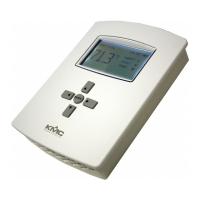BAC-1xx63/1xxx63 Series (6 Relays and 3 Analog Outputs) Section 41 Application Guide L
Economizer Control
If the AHU application is congured for the economizer option, the
economizer sequence described in the Common Features section is fol-
lowed.
Dehumidification
If the dehumidication sequence is enabled on models BAC-
10163C/11163C, the dehumidication mode is started and stopped as
described in the Common Features section. Upon activation of the dehu-
midication mode, the cooling valve is opened 100%. The heating valve
then reheats the space as called for in a modied heating sequence to
maintain the active cooling setpoint. Upon termination of the dehumidi-
cation mode, the valves return to their normal sequence.
An option is provided to prevent the FlexStat from going into dehu-
midication mode if it is presently operating in the heating mode. If
the option “allow htg dehum” is set to “yes,” then dehumidication as
described above can operate at any time. If the “allow htg dehum” op-
tion is set to “no,” then the dehumidication mode is allowed to operate
normally if the FlexStat is presently cooling. If the “allow htg dehum”
option is set to “no” and the FlexStat is presently heating, then the dehu-
midication mode is automatically stopped.
HPU (Heat Pump Unit)
Fan Control
The fan follows the base sequence for fan operation as listed above if the
heat pump application is congured for one stage of compressor.
If the heat pump application is congured for two stages of compres-
sor, the fan follows the base sequence for fan operation described in the
Common Features section with the following exception. If the fan mode
is set to “Auto,” the fan will start if the space temp rises above the active
cooling setpoint plus one half the deadband and will stop if the space
temp drops below the active cooling setpoint. If the space temp drops
below the active heating setpoint minus one half the deadband, the fan
will start and stop when the fan rises above the active heating setpoint.
This will allow only one stage of heating or cooling to run if necessary.
Fan o delays apply as previously described.
Reversing Valve
The reversing valve can be congured through the user interface to be
energized on a call for heating (“B” function) or energized on a call for
cooling (“O” function). If the reversing valve is congured to be en-
ergized on a call for heating (“B”), the reversing valve output will be
energized any time there is a call for heating and de-energized on a call
for cooling.If the reversing valve is congured to be energized on a call
for cooling (“O”), the reversing valve output will be energized any time
there is a call for cooling and de-energized on a call for heating.
Compressor Staging
The sequence for the compressor staging depends on the number of
congured stages in the heat pump application:
• If the application is congured for one compressor stage, the
following sequence is used. If the space temperature rises above
the active cooling setpoint plus the deadband AND the compres-
sor has been o at least the minimum o time, the compressor
is energized. If the space temp drops below the active cooling
setpoint, the compressor is de-energized. If the space temp drops
below the active heating setpoint minus the deadband AND the
compressor has been o the minimum o time, the compressor
will be energized. If the space temp rises above the active heating
setpoint, the compressor is de-energized.
• If the application is congured for two compressor stages, the
following sequence is used. In the heating mode, if the space
temperature drops below the active heating setpoint minus one
half the deadband AND the rst stage of compressor has been
o for at least the minimum o time, the rst stage of compres-
sor will be energized. If the space temp further drops below the
active heating setpoint minus the deadband AND the rst stage
of compressor has been energized for at least the stage delay
AND the second stage of compressor has been o for at least the
minimum o time, the second stage of compressor will be ener-
gized. Upon rise in temperature above the active heating setpoint
minus one half the deadband, the second stage of compressor
will be de-energized. Upon further rise in temperature above the
active heating setpoint, the rst stage of compressor will be de-
energized. In the cooling mode, if the space temp rises above the

